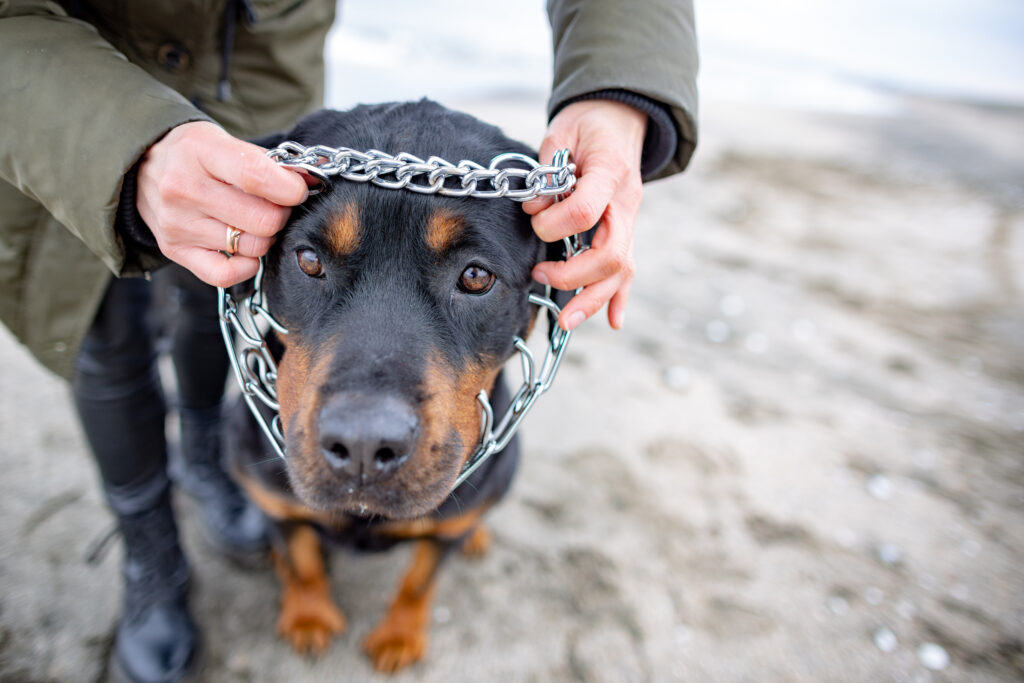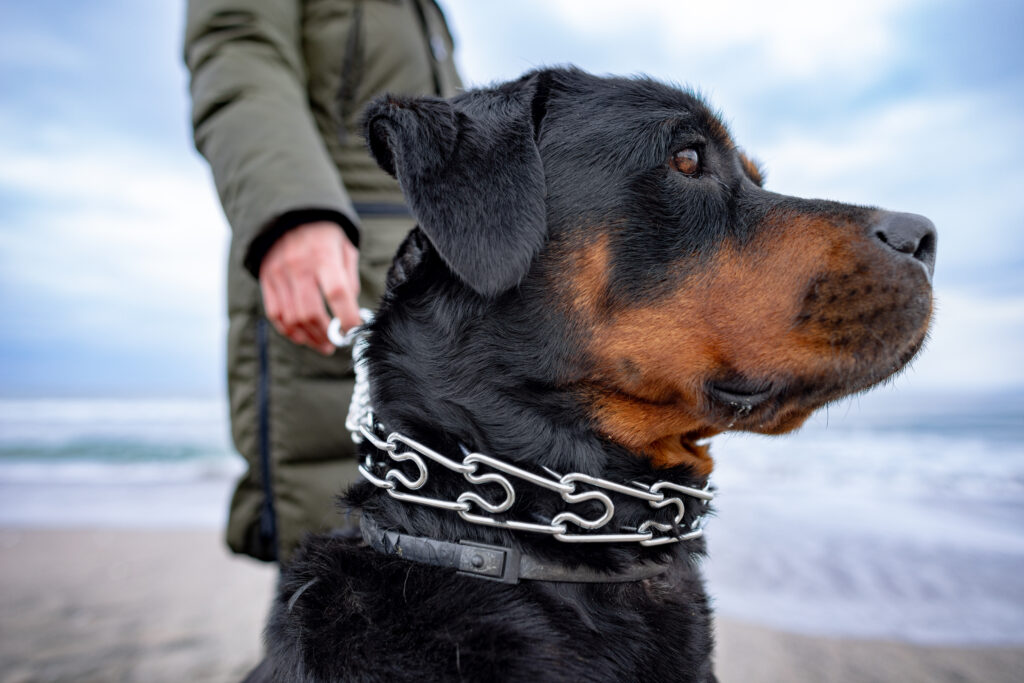If you’ve ever struggled to control your dog during walks or found it challenging to correct certain behaviors, you might have considered prong dog collars as a potential solution. These collars often stir up controversy, with some people advocating their effectiveness and others concerned about their potential for harm. However, prong dog collars can be safe, humane, and extremely valuable training tools when used correctly. To make an informed decision about using these collars when training your dog, let’s break down what prong dog collars are, address the associated controversy, and learn how and when to use them safely and effectively.
Understanding Prong Dog Collars
Prong dog collars, also known as pinch collars, are designed with a series of metal prongs that rest against a dog’s neck. When tension is applied to the leash, the prongs pinch the dog’s skin, mimicking the natural correction a mother dog gives her puppies. This makes them different from standard flat collars or choke chains, as they distribute pressure evenly around the neck, reducing the risk of injury when used properly.
Addressing The Controversy
There’s no denying that prong collars have their critics. Many concerns stem from misuse, where improper fitting or harsh corrections can indeed cause discomfort or harm. Critics argue that they can be painful and lead to fear or aggression if not used correctly. However, advocates of prong collars emphasize that, with proper education and usage, these tools can be both safe and effective.
The key is understanding that prong collars should not be used as a punishment device but as a communication tool. When used appropriately, they can gently and effectively guide dogs without causing harm. This means no yanking or jerking – just gentle pressure and release to signal desired behaviors.
When to Use a Prong Dog Collar
Prong collars can be particularly useful in specific training scenarios and for certain types of behavioral issues. Here are some situations where a prong collar might be appropriate:
Leash Pulling: For dogs that pull excessively on the leash, prong collars can provide the control needed to make walks more enjoyable and safe for both the dog and the owner.
Behavioral Correction: Dogs that exhibit challenging behaviors like lunging, jumping, or aggressive tendencies can benefit from the gentle correction a prong collar provides.
Training Large or Strong Dogs: Owners of large breeds or particularly strong dogs may find prong collars helpful in managing their dogs more effectively.
It’s important to note that prong collars are not for every dog. They should not be used on puppies or small breeds with delicate necks. Consulting with a professional trainer to assess your dog’s specific needs is always a good step before deciding to use a prong collar.

How to Use a Prong Collar Properly
Using a prong dog collar correctly is crucial for ensuring your dog’s safety and comfort. Here are some steps to follow:
Proper Fitting: Make sure the collar fits snugly but comfortably around your dog’s neck, just below the ears. It should not be too loose or too tight. You should be able to slide one finger between the collar and your dog’s skin.
Introduction: Gradually introduce your dog to the collar. Allow them to wear it for short periods without any leash attachment to get used to the sensation.
Correct Usage: Use gentle pressure and release techniques. When your dog exhibits unwanted behavior, apply a gentle pull on the leash to activate the prongs, then immediately release the pressure. This quick correction helps the dog understand which behaviors are not acceptable.
Supervision: Always supervise your dog while using a prong collar to ensure they are responding well and not experiencing any distress.
Training Tips
Prong collars are a short-term training tool. Some dogs respond to the training faster than others. However, training with a prong collar should not last more than six months
To maximize the effectiveness of prong collars, combine their use with positive reinforcement techniques. Reward your dog with treats, praise, or play when they exhibit desired behaviors. This combination of correction and reward helps reinforce good behavior more effectively than correction alone.
Avoid common mistakes such as using the prong collar as a punishment tool, applying excessive force, or leaving the collar on your dog unattended. Regularly monitor your dog’s progress and adjust your training methods as needed. If you notice any signs of fear or discomfort, it may be time to consult with a professional trainer for guidance.
Benefits of Prong Collars
When used correctly, prong collars offer some valuable benefits.
Increased Control: They provide better control during walks, especially for large or strong dogs, making outings more enjoyable and safer.
Improved Response: Dogs often respond more quickly to prong collar corrections, reducing the time needed to train desired behaviors.
Stronger Bond: Effective training with prong collars can strengthen the bond between you and your dog, as clear communication leads to better understanding and trust.

Consult with the Experts
Prong dog collars, despite their controversy, can be effective training tools when used with care and understanding. However, proper usage and positive reinforcement are key to ensuring your dog’s safety and well-being.
At Beau’s K9 Academy, we understand the importance of using the right tools for effective dog training. Our experienced trainers are here to help you make informed decisions and provide professional guidance tailored to your dog’s needs.
Still have questions about prong dog training collars? The professionals at Beau’s K9 Academy can answer your questions and help you choose the right collar for your dog from their quality selection.
We offer basic training, board and train, and even behavior modification. The options to train your canine companion are endless at Beau’s K9 Academy. Contact us today to find the best training solutions for you and your furry friend.
Prong Dog Collar FAQs
Are prong dog collars safe?
Yes, when used correctly, prong collars are safe and can be effective training tools. It is crucial to use them as a communication tool, not as a punishment device.
When should I use a prong dog collar?
Prong collars are useful for training scenarios like leash pulling, behavioral correction, and managing large or strong dogs. They are not recommended for puppies or small breeds.
How do I fit a prong dog collar on my dog?
Ensure the collar fits snugly but comfortably just below the ears. You should be able to slide one finger between the collar and your dog’s skin.
How should I introduce my dog to a prong collar?
Gradually introduce the collar by allowing your dog to wear it for short periods without a leash attachment. Use gentle pressure and release techniques for corrections.
Can prong collars be used with positive reinforcement?
Yes, combining prong collars with positive reinforcement like treats, praise, or play can enhance training effectiveness and encourage desired behaviors.
Where can I get professional advice on using prong collars?
At Beau’s K9 Academy, our experienced trainers can provide expert guidance on using prong collars safely and effectively. Contact us for professional advice and to explore our quality selection of training collars.

